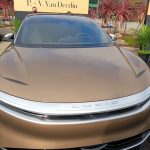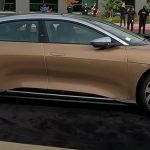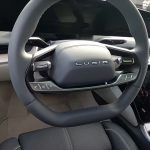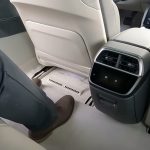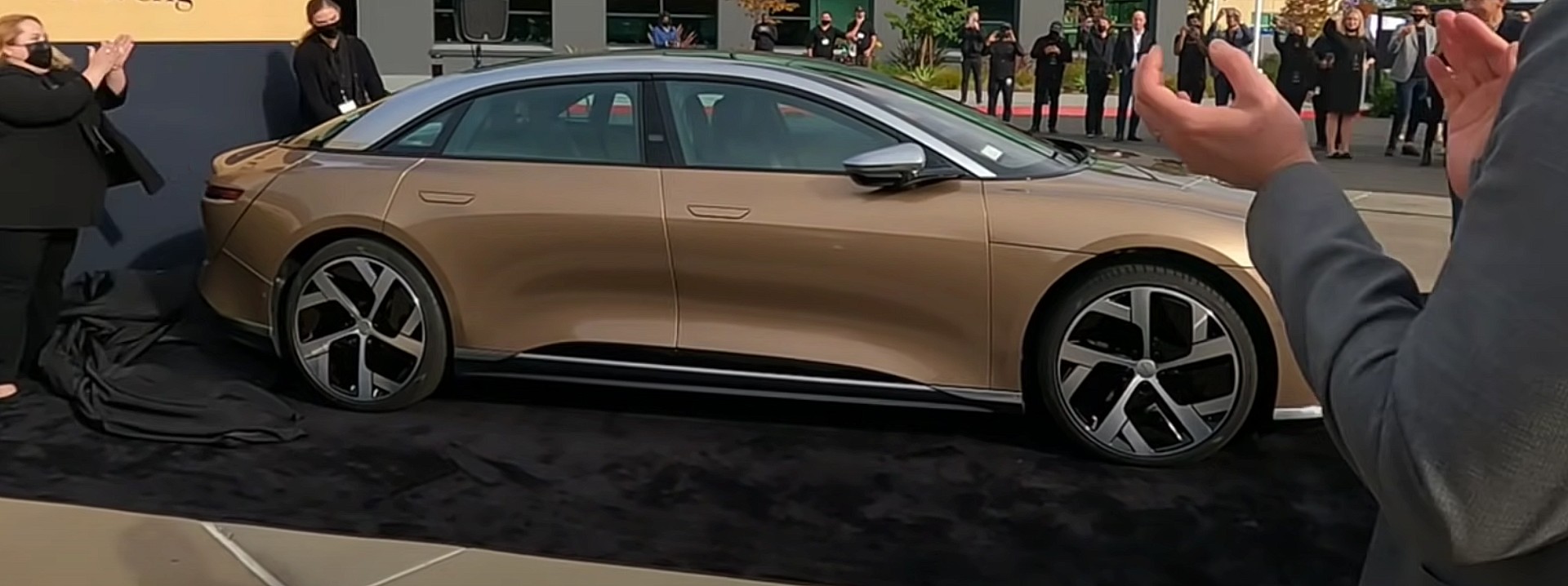

News
Lucid Air Dream Edition shows impressive initial build quality thanks to human craftsmanship
With the Lucid Air Dream Edition finally beginning initial deliveries more than a year after its unveiling, the automaker’s first builds are showing an impressive build quality thanks to Lucid’s focus on fine craftsmanship. A spacious, luxury interior also fills the inside of the Air Dream Edition, giving the impression that first owners are more than happy with what they have been given after a lengthy wait.
Vivianna Van Deerlin was one of the first owners of the Lucid Air Dream Edition and attended the October 30th, 2021 unveiling event in California. While Van Deerling attended the West Coast-located ceremony, which included breakfast, numerous speeches from Lucid executives, and a trunk full of Lucid-inspired goodies, she is a resident of New Jersey, and putting 3,000 miles on the car in the first few days was not what she planned for. The vehicle was then shipped to New Jersey, where she plans to take delivery soon.
However, a video Van Deerlin took at the Lucid Delivery Event in California showed the impressive build quality the Air sports in its early builds, and it may be the reason the car was awarded MotorTrend’s “Car of the Year” award. Lucid has already detailed that the first few units of the Air would be built by hand. In March, Lucid detailed the tedious-but-necessary process of taking out automation and bringing humans in to build the cars. It eliminates the uncertainty of mass production, and while fewer units can be built, quality is unmatched. “At this stage in the process, it’s less about the robots and more about the hands-on human element. It’s all carefully choreographed,” Lucid wrote in its blog. “We do have some robots and we do have automation, but this vehicle is put together by humans. And it takes real craftsmanship,” Art Schlaud, Director of Manufacturing for General Assembly said.
Lucid shows the tedious process of building the Air Dream Edition
If the Air Dream Edition delivery event told us anything, it’s that Lucid is bringing its finest vehicles to the forefront during its shiny-and-pretty delivery event. The cars are nearly flawless, and the exterior is almost as pretty as the interior.
- Credit: Vivianna Van Deerlin | YouTube
- Credit: Vivianna Van Deerlin | YouTube
Van Deerlin may be one of the most qualified people on Earth to give a first impression of an EV. In 2009, Van Deerlin was a Model S reservation holder, and took delivery of an S85 in December 2012, she said. There was no infrastructure, Superchargers were not a thing, and electrification was far away from the mainstream. “It was a gamble at the time, but we believed firmly in the mission to transition the world to sustainable energy, so were excited to be early adopters of Tesla and help spread the word,” Van Deerlin said.
Lucid’s competitive nature, which has included plenty of mention of rival Tesla, does not make anything different for Van Deerlin. “This purchase of a Lucid Air in no way diminishes my passion for my Tesla vehicles, energy products and the Tesla community. I love our Model 3, Model S, and Roadster. For anyone who truly believes in the Tesla mission, and not just making money from Tesla stock, the success of more than one EV company is imperative. I see a future of transition to electric vehicles — but I do not see a future where everyone drives a Tesla,” she said on YouTube.
- Credit: Vivianna Van Deerlin | YouTube
- Credit: Vivianna Van Deerlin | YouTube
Build quality is a term that many Tesla enthusiasts are familiar with because it was a strong point of conversation for media for some time. Tesla was struggling with build quality when ramping up the Model 3 several years ago, after having the reputation of well-built cars with early adaptations of the Model S being handbuilt. CEO Elon Musk has always said that “production is hard,” and Lucid may get to experience that lesson in a few years when it begins to mass-produce the Air sedan or the “Project Gravity” SUV it will unveil. The real question is whether Lucid will be able to keep this impressive build quality up while it begins to scale its manufacturing processes. Past experiences have taught us that automakers tend to struggle with perfect build quality while balancing thousands of units per day.
Nevertheless, Lucid brought its A-game for its first impressions. Check out Van Deerlin’s video on the delivery experience below.
I’d love to hear from you! If you have any comments, concerns, or questions, please email me at joey@teslarati.com. You can also reach me on Twitter @KlenderJoey, or if you have news tips, you can email us at tips@teslarati.com.

News
Tesla FSD fleet is nearing 7 billion total miles, including 2.5 billion city miles
As can be seen on Tesla’s official FSD webpage, vehicles equipped with the system have now navigated over 6.99 billion miles.

Tesla’s Full Self-Driving (Supervised) fleet is closing in on almost 7 billion total miles driven, as per data posted by the company on its official FSD webpage.
These figures hint at the massive scale of data fueling Tesla’s rapid FSD improvements, which have been quite notable as of late.
FSD mileage milestones
As can be seen on Tesla’s official FSD webpage, vehicles equipped with the system have now navigated over 6.99 billion miles. Tesla owner and avid FSD tester Whole Mars Catalog also shared a screenshot indicating that from the nearly 7 billion miles traveled by the FSD fleet, more than 2.5 billion miles were driven inside cities.
City miles are particularly valuable for complex urban scenarios like unprotected turns, pedestrian interactions, and traffic lights. This is also the difference-maker for FSD, as only complex solutions, such as Waymo’s self-driving taxis, operate similarly on inner-city streets. And even then, incidents such as the San Francisco blackouts have proven challenging for sensor-rich vehicles like Waymos.
Tesla’s data edge
Tesla has a number of advantages in the autonomous vehicle sector, one of which is the size of its fleet and the number of vehicles training FSD on real-world roads. Tesla’s nearly 7 billion FSD miles then allow the company to roll out updates that make its vehicles behave like they are being driven by experienced drivers, even if they are operating on their own.
So notable are Tesla’s improvements to FSD that NVIDIA Director of Robotics Jim Fan, after experiencing FSD v14, noted that the system is the first AI that passes what he described as a “Physical Turing Test.”
“Despite knowing exactly how robot learning works, I still find it magical watching the steering wheel turn by itself. First it feels surreal, next it becomes routine. Then, like the smartphone, taking it away actively hurts. This is how humanity gets rewired and glued to god-like technologies,” Fan wrote in a post on X.
News
Tesla starts showing how FSD will change lives in Europe
Local officials tested the system on narrow country roads and were impressed by FSD’s smooth, human-like driving, with some calling the service a game-changer for everyday life in areas that are far from urban centers.

Tesla has launched Europe’s first public shuttle service using Full Self-Driving (Supervised) in the rural Eifelkreis Bitburg-Prüm region of Germany, demonstrating how the technology can restore independence and mobility for people who struggle with limited transport options.
Local officials tested the system on narrow country roads and were impressed by FSD’s smooth, human-like driving, with some calling the service a game-changer for everyday life in areas that are far from urban centers.
Officials see real impact on rural residents
Arzfeld Mayor Johannes Kuhl and District Administrator Andreas Kruppert personally tested the Tesla shuttle service. This allowed them to see just how well FSD navigated winding lanes and rural roads confidently. Kruppert said, “Autonomous driving sounds like science fiction to many, but we simply see here that it works totally well in rural regions too.” Kuhl, for his part, also noted that FSD “feels like a very experienced driver.”
The pilot complements the area’s “Citizen Bus” program, which provides on-demand rides for elderly residents who can no longer drive themselves. Tesla Europe shared a video of a demonstration of the service, highlighting how FSD gives people their freedom back, even in places where public transport is not as prevalent.
What the Ministry for Economic Affairs and Transport says
Rhineland-Palatinate’s Minister Daniela Schmitt supported the project, praising the collaboration that made this “first of its kind in Europe” possible. As per the ministry, the rural rollout for the service shows FSD’s potential beyond major cities, and it delivers tangible benefits like grocery runs, doctor visits, and social connections for isolated residents.
“Reliable and flexible mobility is especially vital in rural areas. With the launch of a shuttle service using self-driving vehicles (FSD supervised) by Tesla in the Eifelkreis Bitburg-Prüm, an innovative pilot project is now getting underway that complements local community bus services. It is the first project of its kind in Europe.
“The result is a real gain for rural mobility: greater accessibility, more flexibility and tangible benefits for everyday life. A strong signal for innovation, cooperation and future-oriented mobility beyond urban centers,” the ministry wrote in a LinkedIn post.
News
Tesla China quietly posts Robotaxi-related job listing
Tesla China is currently seeking a Low Voltage Electrical Engineer to work on circuit board design for the company’s autonomous vehicles.

Tesla has posted a new job listing in Shanghai explicitly tied to its Robotaxi program, fueling speculation that the company is preparing to launch its dedicated autonomous ride-hailing service in China.
As noted in the listing, Tesla China is currently seeking a Low Voltage Electrical Engineer to work on circuit board design for the company’s autonomous vehicles.
Robotaxi-specific role
The listing, which was shared on social media platform X by industry watcher @tslaming, suggested that Tesla China is looking to fill the role urgently. The job listing itself specifically mentions that the person hired for the role will be working on the Low Voltage Hardware team, which would design the circuit boards that would serve as the nervous system of the Robotaxi.
Key tasks for the role, as indicated in the job listing, include collaboration with PCB layout, firmware, mechanical, program management, and validation teams, among other responsibilities. The role is based in Shanghai.
China Robotaxi launch
China represents a massive potential market for robotaxis, with its dense urban centers and supportive policies in select cities. Tesla has limited permission to roll out FSD in the country, though despite this, its vehicles have been hailed as among the best in the market when it comes to autonomous features. So far, at least, it appears that China supports Tesla’s FSD and Robotaxi rollout.
This was hinted at in November, when Tesla brought the Cybercab to the 8th China International Import Expo (CIIE) in Shanghai, marking the first time that the autonomous two-seater was brought to the Asia-Pacific region. The vehicle, despite not having a release date in China, received a significant amount of interest among the event’s attendees.
